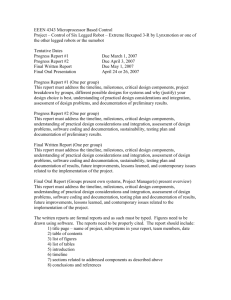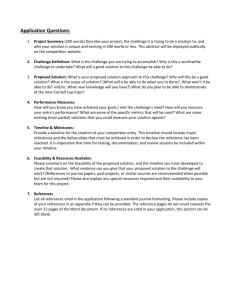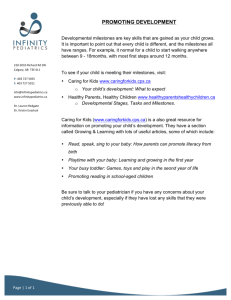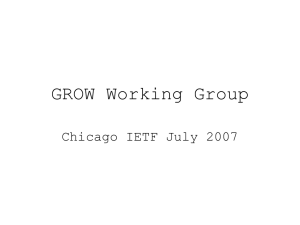Writing an Effective Proposal
advertisement
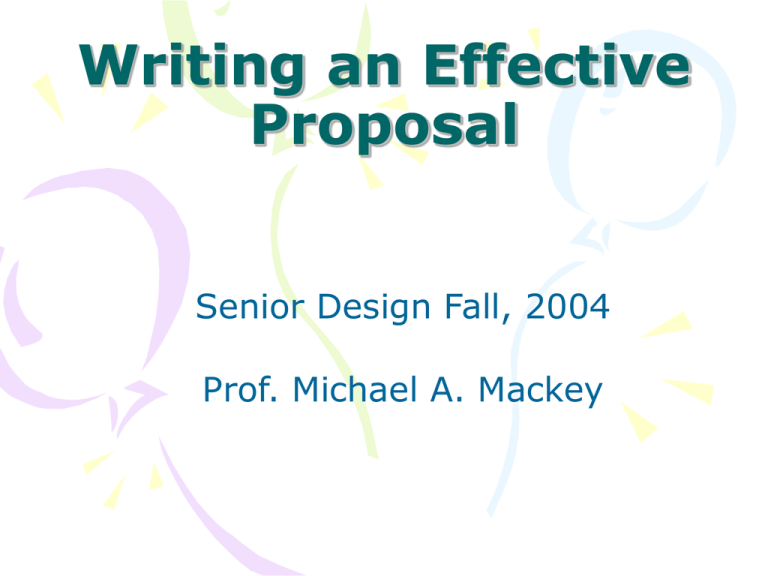
Writing an Effective Proposal Senior Design Fall, 2004 Prof. Michael A. Mackey Proposal Writing • • • • • What is the point? Use a clear writing style Get the correct format Put all the bits in place Leave enough time to polish the document Why work to perfect the art of proposal writing? • Organize your thinking • Communicate your expertise • Impress and Conquer • Get the Job Done! Writing Style • A clear writing style greatly aids in getting your point across • Unclear writing makes the reviewer have to work harder, and it will usually cost you in the end • Start with an outline, containing important points you want to make for each section of the proposal • Then, develop a single paragraph for each point you want to make. • • • • • • • • • • Main Structure – Device-Based Design Project Executive Summary Background and Significance Requirements Feasibility and Summary of Design Validation Deliverables Legal and Regulatory Issues Timeline / Milestones Summary References Main Structure – Research-Based Design Project • • • • • • • • • Executive Summary Hypothesis and Specific Aims Background and Significance Preliminary Studies Research Plan Legal and Regulatory Issues Timeline / Milestones Summary References Both Project Types: Executive Summary • A concise, non-technical summary of the entire document • This summary should describe the motivation for the work • Brief summary of the proposed approach • Nothing should be here that is not in the body of the text • Space Limit: 300 words. Research-Based Project: Hypothesis/Specific Aims Enumerate your Hypotheses and related Aims: – Hypothesis I • Aim 1 • Aim 2 – Hypothesis II • Aim 3 (etc) • Remember: You don't necessarily need multiple hypotheses • This is the most important part of a Research-based project proposal • Space limit: ½ page Both Project Types: Background / Significance • This part describes the background relevant to the problem at hand • You also use this section to convince the reviewer that you are aware of the important background literature for the problem • You usually want to discuss what benefits will be produced by the proposed work • Suggested number of pages: 2-3 Device-Based Projects: Requirements • Clearly identify the requirements and constraints on your proposed design. These might include functional or manufacturing requirements. • Include safety, cost and marketing constraints, etc. • This is the design specification for your project • Recommended: ½ page (might be longer for some projects) Device-Based Projects: Feasibility and Summary of Design • Briefly describe one or two possible design approaches • This section should convince the reviewer that this project can be successfully completed on time • Be sure that your proposed design(s) satisfy the project requirements • Are there any financial issues? • Suggested page length: 1-2 pages Device-Based Project: Validation and Testing • Describe your proposed techniques for determining if the device works, and otherwise meets your requirements (this information will be summarized in your Milestones) Research-Based Projects: Preliminary Studies • Include any scientific or engineering content relevant to your project • You don't absolutely need this section, but it usually makes for a better proposal • If you have no preliminary data, and other data in the literature is not critical for the feasibility of your project, don't include this section • Although this section frequently includes your own preliminary data, don't be afraid to use data published by others (appropriately referenced), but only if you have a very good reason • This section communicates to the reviewer your expertise in critically understanding what is needed for your approach to work. Both Project Types: Legal and Regulatory Issues • What special legal or regulatory issues do you have? – FDA approval needed? – IRB / IACUC approval needed ? – societal issues involved? Research-Based Projects: Research Plan • Organize your proposed experiments by Specific Aim – Briefly restate the Specific Aim – Describe in detail the experiments you will perform for this Aim. • If you have a lot of experimental details you want to include, put in a separate section following this one entitled “General Methods” • The goal for this section is to have give a clear description of the details of your approach to test the project hypotheses • Suggested page length: 3-4 pages Device-Based Projects: Deliverables • Describe precisely what your project will produce. • Will be referred to (most likely) in your Milestones • Suggested page length: ½ page Both Project Types: Timeline and Milestones • Using a table, indicate the timeline for this project • Describe 2 or three Milestones for the project – A good milestone is a quantitative endpoint which will guarantee success for the project – Set reasonable dates for achievement of your milestones Both Project Types: Summary • Write a one-paragraph summary of what the project will accomplish. Highlight the benefit of the work • Limit: one paragraph References: APA Format Example Formats • • • Journal article: – Fine, M. A., & Kurdek, L. A. (1993). Reflections on determining authorship credit and authorship order on faculty-student collaborations. American Psychologist, 48, 1141-1147. Book: – Nicol, A. A. M., & Pexman, P. M. (1999). Presenting your findings: A practical guide for creating tables. Washington, DC: American Psychological Association. Book chapter: – O'Neil, J. M., & Egan, J. (1992). Men's and women's gender role journeys: Metaphor for healing, transition, and transformation. In B. R. Wainrib (Ed.), Gender issues across the life cycle (pp. 107-123). New York: Springer. References: APA Format Electronic References ● Online periodical: – ● Author, A. A., Author, B. B., & Author, C. C. (2000). Title of article. Title of Periodical, xx, xxx-xxx. Retrieved month day, year, from source (give URL). Online document: – Author, A. A. (2000). Title of work. Retrieved month day, year, from source (give URL) CTC – get help! • The Center for Technical Communication will be happy to help you in writing your proposal (and you will get 5 extra points!) • To ensure that there will be enough time for the Center to read and advise you on your proposal, you must submit it to them by Oct. 26th (the full proposal is due on Oct. 29th) Final Recommendations • Give yourself enough time to get everything in place • You can divide up the proposal into parts for each team-member to complete, but have one person do a final edit for style and language usage • Polish, polish, polish – you will be glad you did

